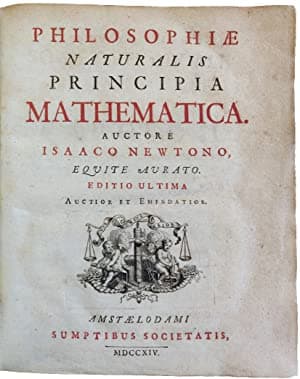Exploring "Philosophiæ Naturalis Principia Mathematica"

The "Philosophiæ Naturalis Principia Mathematica" (Mathematical Principles of Natural Philosophy) is a monumental scientific work authored by Sir Isaac Newton, one of the greatest minds in the history of science. Published in 1687, this three-volume masterpiece forever transformed our understanding of the physical world and laid the foundation for classical mechanics.
Background and Significance
Before the publication of Newton's Principia, the scientific community lacked a comprehensive and unified framework to explain the motion of celestial bodies and the behavior of objects on Earth. Newton's groundbreaking work provided a systematic approach to studying and describing the laws that govern the natural world. It marked a turning point in the history of physics and set the stage for subsequent scientific discoveries and advancements.
Three Laws of Motion
At the heart of the Principia are Newton's three laws of motion, which form the cornerstone of classical mechanics:
-
Law of Inertia: The first law, often referred to as the law of inertia, states that an object at rest will remain at rest, and an object in motion will continue moving at a constant velocity unless acted upon by an external force.
-
Law of Acceleration: The second law states that the acceleration of an object is directly proportional to the net force acting on it and inversely proportional to its mass. Mathematically, this relationship is expressed as F = ma, where F represents the force applied to an object, m is its mass, and a denotes its acceleration.
-
Law of Action and Reaction: The third law, known as the law of action and reaction, states that for every action, there is an equal and opposite reaction. In other words, when an object exerts a force on another object, the second object exerts an equal and opposite force on the first.
These laws revolutionized our understanding of motion, providing a unified framework to explain the behavior of objects both on Earth and in the cosmos.
Theory of Universal Gravitation
Another groundbreaking concept presented in the Principia is Newton's theory of universal gravitation. Newton proposed that every particle of matter attracts every other particle with a force that is directly proportional to the product of their masses and inversely proportional to the square of the distance between them. This theory provided a comprehensive explanation for the motion of celestial bodies, such as planets, moons, and comets.
Impact and Legacy
The publication of the Principia marked a watershed moment in the history of science. It not only revolutionized our understanding of the physical world but also provided a solid mathematical foundation for studying the natural phenomena. Newton's work laid the groundwork for future advancements in physics, astronomy, and engineering.
The Principia's impact extended far beyond the scientific community. Its emphasis on empirical observation, rigorous experimentation, and mathematical reasoning set a standard for scientific inquiry that still resonates today. Newton's ideas have influenced generations of scientists and continue to shape our understanding of the universe.
In conclusion, the "Philosophiæ Naturalis Principia Mathematica" stands as one of the most significant scientific works ever published. Newton's profound insights into the laws of motion and the theory of universal gravitation laid the foundation for modern physics and revolutionized our understanding of the natural world. Its enduring legacy serves as a testament to the power of human intellect and the pursuit of scientific knowledge.